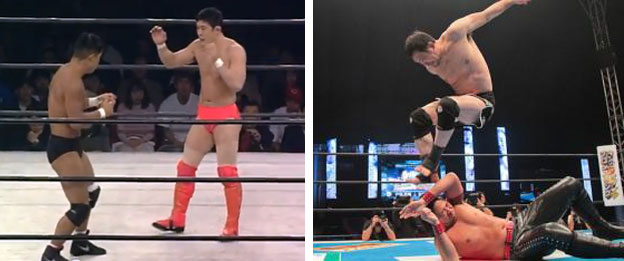
What many people did not realize was the pedigree that Sakuraba had inherited. Sakuraba was not simply a fighter with a personality. He was a rare athlete that understood the proper application and uses of the moves he had picked up in the ring. In pro wrestling circles the Japanese style was known to be very stiff or hard-hitting. The strikes were pulled to a lesser degree than those performed in the US which gave the fighting art some credibility to audiences. In fact some promotions prided themselves on highlighting realistic combat. The UWF promotion that Sakuraba worked with had rules that were closer to vale tudo than the pro wrestling that Westerners were used to. Fighters performed locks, holds and hard-hitting strikes that were designed to convince audiences that each fight was a "shoot" or a real battle.
There was a reason that the Japanese style of wrestling was hard-hitting. The man that helped shape the wrestling game in Japan was Karl Gotch. He trained many of the best fighters in the game, including Antonio Inoki. Remember he was the guy that fought Ali? Karl was considered the God of Wrestling to the Japanese, holding a place of prestige that may be even greater than Rikidozan. Gotch himself had been trained in a legacy that dated back to the birth of scientific or "catch-as-catch-can" wrestling from the late 19th century. Sakuraba embraced the roots of Japanese wrestling and began learning the moves from the other masters of the game. It would turn out to be the secret weapon that he used in getting past the BJJ system.
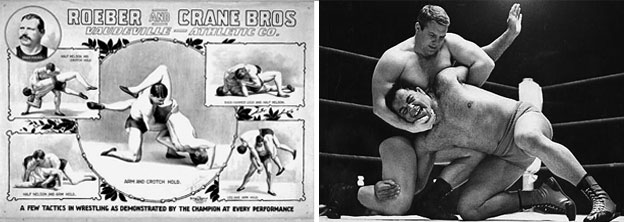
Grappling was the oldest known fighting art. It went well back in time when the earliest civilizations were getting established. Warriors and soldiers needed to learn how to fight unarmed in service of their emperors. Systems had to be established that relied on painful joint locks to subdue attackers and disarm opponents. Even laymen had to learn how to defend themselves in the event of a robbery attempt. The best fighters competed in early tournaments. In the Mediterranean the local nations would compete in regional wrestling tournaments before the rise of the modern Olympics. The ancestor to Roman-Greco wrestling had a second fighting art that developed alongside it. The pankration was a mix of wrestling and boxing, for all intents and purposes it was the first mixed martial art style or tournament. Fighters were allowed more leeway with their strikes but eye gouging and biting was still not permitted. Pankration, wrestling and boxing paintings adorned pottery, jewelry, statues and carved reliefs several thousand years old. Pankration was big in ancient times and the mythical heroes Hercules and Theseus were said to be masters of the art.
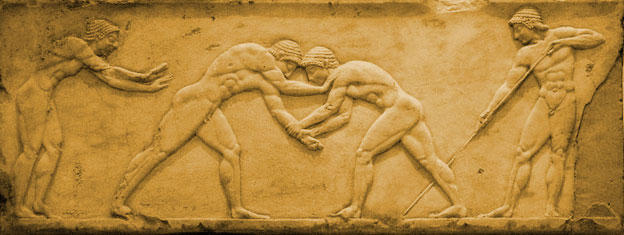
The names of the early champions were recorded by ancient historians. The legacy of those fighters survived more than 2,000 years. It showed that truly great fighters would indeed achieve immortality. A post apocalyptic animated comic named Pancratia by Ryan Benjamin was inspired by those heroes and their everything goes fighting style.
History books, as well as the graphic novel and movie series "300" reminded people that the Spartans were exceptionally dangerous because they trained in every form of combat from a young age. It was said that Alexander the Great surrounded himself with the best pankratia fighters from his army. According to historians other cultures were exposed to the fighting art during his campaigns and incorporated it into their own wrestling traditions.
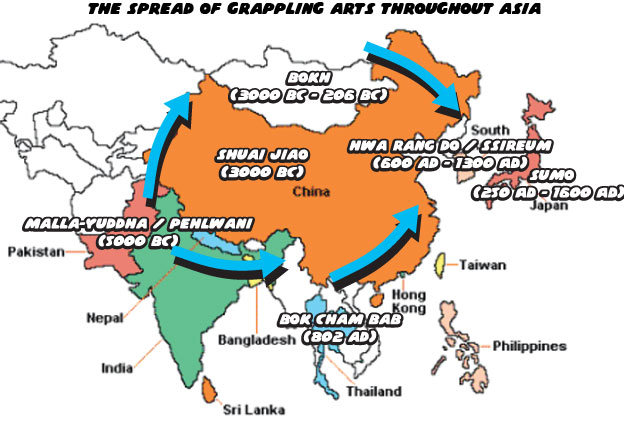
In 326 B.C. Alexander's campaign had taken his army through India where the western arts cross pollinated with another equally ancient form of wrestling. The early Buddhists took elements of the grappling arts north with them into China. It turns out that the striking arts were not the only things that migrated East. As many martial arts fans know the kung-fu forms influenced the development of the fighting arts in the southern part of the continent, Thailand and Cambodia as well as in the north like Mongolia. By the time traders settled in the islands to the far east they had taken their cross pollination of forms and planted the seeds for karate, judo and jujitsu.
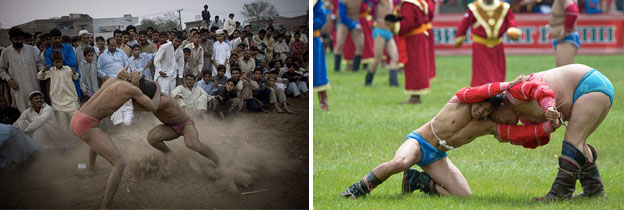
Japan developed Sumo wrestling. Sumo wrestling has a rich history, a detailed tapestry of ethnic identity. Religious, mythological and royal characters have all been associated with the sport. Sumo has been called the most physically demanding of all the martial arts. The best wrestlers or yokozunas are the stuff of legend, massive men whose speed and ability beguile their size. Why wouldn't E. Honda have worked in the Street Fighter series? His strikes and kicks were simply caricatured versions of actual sumo slaps and thrusts. This is something that you should remember of all the classic SF characters. At some point in their design we can trace back an actual art or purpose for their moves and looks. It was only in recent generations of the game that it became disconnected from the martial arts.

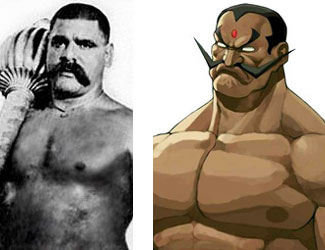
Indian wrestling or "Pehelwani" gave rise to, what I believe to be, the greatest grappler in the Street Fighter universe. Darun Mister from the Street Fighter EX series was inspired by the actual undefeated pehelwani champion Ghulam Muhammad aka the Great Gama. My brothers and I like this character more than the Red Cyclone himself. That is not to say that Zangief was a poorly designed character but his concept version was lacking. A tattooed sailor originally named "Vodka Gobalsky?" With designs like that you'd think that Capcom of Japan wouldn't be surprised by how the west reacted to new characters in SF IV.
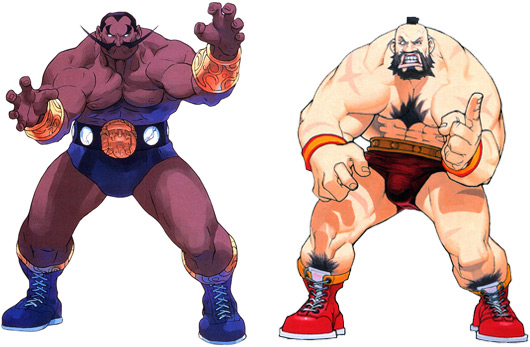
The entire cast of SF EX was created to balance out the original world warriors. Ken and Ryu were balanced by Allen Snider and Kairi respectively. The strong females were balanced out, Chun Li had Blair Dame or Pullum Puruna. The oddballs were balanced out through Dhalsim had Skullomania. Military strongman Guile had Doctrine Dark and of course Zangief had Darun. Darun had to be as exaggerated in proportions as the burly Russian, and have equally fantastic wrestling moves. His dark skin color and trunks even balanced out the fair skin and bright shorts of 'geif. But there was a certain je nai se quoi that made Darun special. It was more than the upturned mustache or elephant champion belt, although those were cool touches as well.

The Pehelwani techniques must have worked because Gama was a physical specimen as much as he was a wrestling spectacle. When you think back to the early 1900's there weren't many physiques that could have compared with modern bodybuilders, Gama was one of the few exceptions. Some of his strength training formats are still practiced by people around the world. Unfortunately for every up there was a down. He would find criticism for his reliance on standing wrestling skills without developing proper mat skills. This and the diet he was on helped increase his bulk but eventually lead to his heart condition. Early physical culture understood the importance of eating large amounts of protein to build mass but unfortunately did not realize that his diet also contributed to his heart disease. You could learn a lot reading about the life and death of the Great Gama. His final days were actually kind of sad as the man who inspired a nation seemed to be forgotten by his fellow Indians.
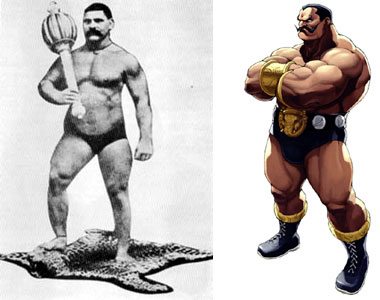
Mr. Zbyszko was another titan of wrestling. He traveled the globe challenging the best in North America and Europe and winning more often than not. Only Frank Gotch had amassed a more impressive record in a tragically shorter time. Stanislaus' defeat at the hands of Gama took on some significance. Mr. Zbyszko probably had nothing to do with the creation of Zangief but Russians like Ivan Poddubny were very much feared at the time. Zbyszko was one of the few to defeat Poddubny.
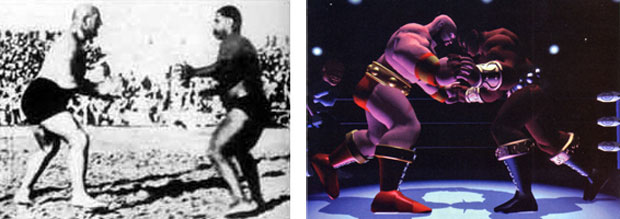
This was when Capcom was going the extra mile in character design. No character could simply be added into the series just for visual appeal, they had to take on an additional context in order to both grab the audiences and compete against the returning legacy characters. Darun was just one of the characters featured in SF EX that was based on a legend. Darun and Zangief were presented as the genuine article. They were not gimmick wrestlers from modern times, or even showmen from the era of Gene Lebell. They were inspired by an earlier time, an era of authenticity. While modern gamers might not know exactly who or when they came from all can agree that they were exceptional designs, straightforward and to the point.
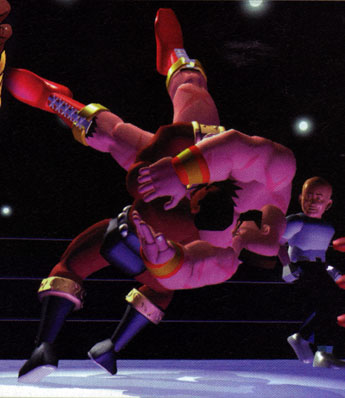

best games to play for kids
ReplyDeletemotu patlu king of kings 2 game
motu patlu games
motu patlu fight games
motu patlu king of king review